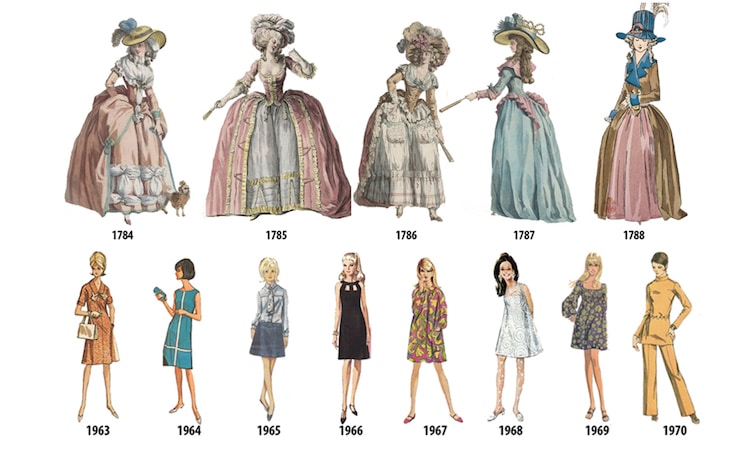Fashion Through the Ages: An Ever-Evolving Canvas
Fashion, an intricate blend of art, culture, and history, has evolved dramatically over the centuries. Each era, with its distinctive style, reflects the social, political, and economic climates of its time. From the opulent dresses of the Renaissance to the bold statements of contemporary fashion, the journey through fashion history is a fascinating exploration of human creativity and societal change.
The Renaissance: Opulence and Elegance
The Renaissance (14th to 17th century) marked a rebirth of art and culture in Europe. Fashion during this period was characterized by opulence and intricate details. The wealthy donned luxurious fabrics like velvet, silk, and brocade, often adorned with elaborate embroidery and jewels. Women’s dresses featured voluminous skirts supported by farthingales and adorned with lace and ruffles, while men sported doublets and hose, highlighting their status and wealth. The period’s fashion was a direct reflection of the era’s fascination with beauty, art, and humanism.
The 18th Century: Extravagance and Revolution
The 18th century witnessed fashion reaching new heights of extravagance, particularly in France under the reign of Louis XVI and Marie Antoinette. Women’s fashion included elaborate gowns with wide panniers, powdered wigs, and excessive use of ribbons, lace, and feathers. However, the latter part of the century saw a dramatic shift with the French Revolution. The revolution brought about a democratization of fashion, favoring simpler styles that symbolized equality and practicality, such as the sans-culottes and the austere dresses of the Directoire period.
The 19th Century: Victorian Modesty and Industrial Influence
The Victorian era (1837-1901) introduced fashion that mirrored the societal norms of modesty and propriety. Women’s fashion featured tightly laced corsets, crinolines, and bustles, creating an hourglass silhouette. The industrial revolution also impacted fashion, making clothing more accessible through mass production. This period saw the rise of ready-to-wear clothing, making fashion more attainable for the middle class.
The Early 20th Century: Innovation and Liberation
The early 20th century was a time of significant change and innovation in fashion. The 1920s, known as the Roaring Twenties, introduced the flapper style with its loose, drop-waist dresses, bobbed hair, and bold accessories. This era symbolized women’s liberation and the breaking of traditional norms. The 1930s and 1940s brought a return to more conservative styles, influenced by the Great Depression and World War II. However, fashion also became more functional, with simpler lines and the use of synthetic fabrics.
The Mid to Late 20th Century: Rebellion and Diversity
The post-war era saw a blossoming of diverse fashion trends. The 1950s were marked by the elegance of Christian Dior’s “New Look,” which reintroduced femininity with its cinched waists and full skirts. The 1960s and 1970s were periods of rebellion and counterculture, with fashion reflecting the social upheavals of the times. The youth-driven styles included miniskirts, bell-bottoms, and psychedelic prints, symbolizing freedom and nonconformit
The Contemporary Era: Eclecticism and Individuality
Today’s fashion is a blend of eclecticism and individuality. The digital age and globalization have made fashion more accessible and diverse than ever before. High fashion and streetwear coexist, and there is a growing emphasis on sustainability and ethical fashion. Contemporary designers draw inspiration from past eras while pushing the boundaries with innovative materials and technologies. Personal style and self-expression have become central, allowing individuals to curate their unique fashion narratives.
Fashion, with its ever-changing nature, is a reflection of society’s evolution. Each period in history leaves its mark on the sartorial landscape, creating a rich tapestry that tells the story of human civilization. From the grandeur of the Renaissance to the eclecticism of today, fashion remains a powerful form of expression and a testament to the creative spirit of humanity.

You May Also Like
Eco-Friendly Fashion
In the dynamic world of fashion, where trends come and go like the changing seasons, there’s one movement that’s here to stay: the sustainability revolution. As the world embraces more eco-conscious choices, the modeling industry is taking a bold step forward, with models leading the charge towards a greener, more ethical fashion future. Welcome to...
The Future of Fashion: Virtual Runways
The fashion industry has always been a dynamic and ever-evolving world, constantly pushing the boundaries of creativity and innovation. In recent years, however, we’ve witnessed a groundbreaking shift that is revolutionizing the way we perceive and engage with fashion. Welcome to the era of virtual runways and digital models, where technology is reshaping the very...